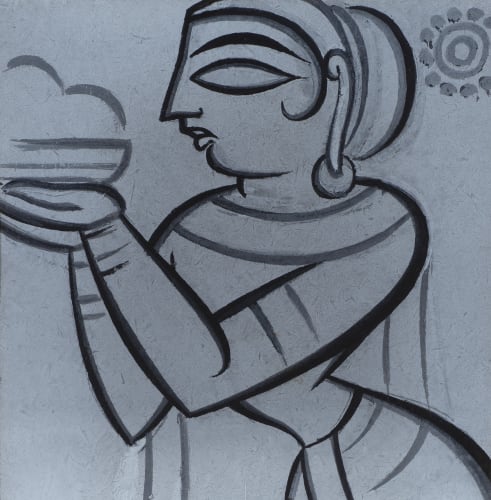Grosvenor Gallery is pleased to present Monochrome, and exhibition of black and white paintings by the Indian artist Jamini Roy (1887-1972). The exhibition will run at the gallery in London from Wednesday 29 April - Friday 16 May 2025.
Although typically recognised for his brightly coloured, exuberant paintings of Indian subjects, mythologies, and folk traditions, Jamini Roy also created a body of relatively minimalist works in black and white. Using natural pigments-lime and lamp black in the case of his monochrome works-he painted his characteristic subjects stripped of ornamentation and saturation, floating against subtly graded backgrounds. This is a rare opportunity to see a collection of these paintings together in one place.
A highlight of the exhibition is a rare and important painting on canvas, dating to the mid-1930s. It was acquired directly from the artist by Humphrey House (1908-1955), a British writer, lecturer, and suspected spy. House was in Calcutta in the mid-1930s teaching at colleges in Madras and Calcutta and was associated with the radical academic journal Parichay. His 1937 satirical pamphlet I Spy with My Little Eye was added to the Raj Government's list of banned literature. During his time in India, House formed a friendship with Jamini Roy and acquired this and several other paintings directly from the artist. This is the first time the painting will be exhibited in public.
Jamini Roy is one of the most well-known Indian artists of the 20th Century, whose iconic imagery is instantly recognisable. He is designated a National Treasure in India, meaning his works cannot be exported from the country. It was common for visitors to acquire Roy's works while in India, and as such his work has spread around the world.
Much in the same way that pilgrims visiting the Kalighat temple in Calcutta would buy a devotional image of a Hindu story, visitors would return from India with their own devotional image of the 'new India', created by a painter who took inspiration from the streets, fields and religious heart of the country.
Of his monochrome works, the artist and critic Rudy Von Leyden commented:
"Jamini Roy went through a phase of monochrome brush drawings during which he purified the quality of his line and trained it to express volume and movement without sacrificing its power to decorative elegance without direct imitation he gave to his Work the monumental power of images."
Two such works - Dancing Gopini and Gopini with Offering, both circa 1940 - are included in the exhibition.
In 1944 when visiting Roy's studio, E. Mary- Milford commented:
"Here was perfect technique of brushstroke, beginning with a broad firm pressure of the brush and ending the curve with a light fine gradation… Jamini carries out these themes in ash-grey line on a background graded from grey to white, giving the effect of figures emerging from a shadowy room or animals leaping across a wide plane."
E. Mary-Milford, A Modern Primitive, Horizon, London, Vol. X, No. 59, 1944
Biography of the Artist:
Jamini Roy was a pioneering Indian modernist painter, widely recognised for his role in shaping modern Indian art by drawing from indigenous traditions and folk art. Born on 11 April 1887, in Beliatore, West Bengal, Roy initially trained in the Western academic style at the Government College of Art in Calcutta (now Kolkata), graduating in 1916 under the tutelage of Abanindranath Tagore.
In his early career, Roy painted in the post-impressionist and academic style influenced by European techniques. However, by the 1920s, disillusioned with Western styles and inspired by nationalist movements, he underwent a radical transformation. He turned to Bengal's folk traditions, especially the Kalighat pat painting and terracotta temple art, seeking a more indigenous, accessible, and rooted visual language.
Roy developed a highly stylised and distinctive form characterised by bold, flat lines and vibrant natural pigments, simplified figures inspired by folk motifs, themes drawn from rural life, Hindu mythology, Christian iconography, the Ramayana, and Krishna legends. His use of traditional materials, such as tempera on cloth or wood, and earthy colours derived from natural pigments further emphasised his connection to Indian roots.
By the 1930s and 1940s, Roy had become one of India's most celebrated artists, with a wide following both in India and abroad. His works were collected by Rabindranath Tagore, Mahatma Gandhi, and Jawaharlal Nehru, and he was one of the earliest Indian artists to gain a dedicated international audience. He was awarded the Padma Bhushan, India's third-highest civilian award, in 1954, and was declared a National Artist by the Government of India in 1955.
Jamini Roy passed away in 1972 in Kolkata. Today, his work is seen as a bridge between tradition and modernity, and he is celebrated for his lifelong commitment to crafting a uniquely Indian modern art form.

